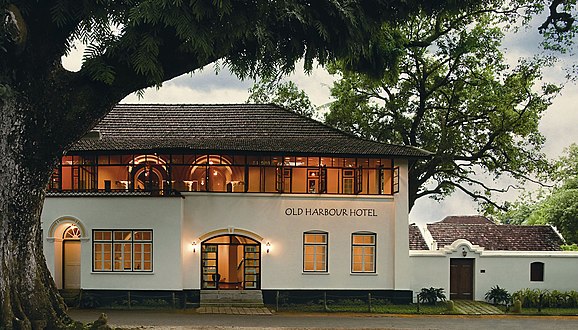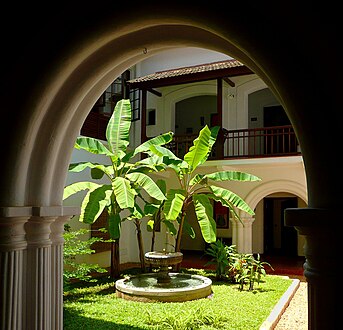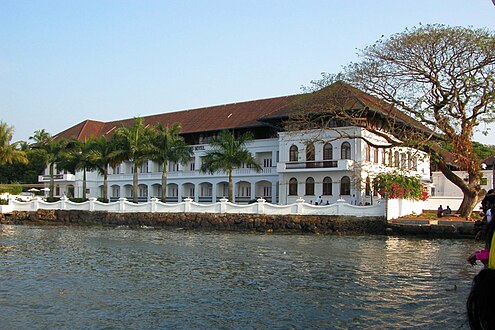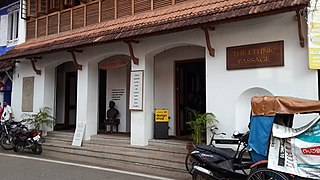Karl Damschen
Karl Damschen (born 15 July 1942 in Gelsenkirchen, Germany) is an architect working in Switzerland and mainly in Kerala, India. His buildings are grounded in the climatic and historico-cultural conditions of each place, and they are significant for the recognition of the great architectural resources of India.

Education and career
[edit]In 1963, Damschen began his studies at the Staatliche Ingenieurschule für Bauwesen Kassel (now University of Kassel), which he completed as a grad. Engineer. After studying with Paul Friedrich Posenenske at the State College of Arts Kassel (now University of Kassel), Damschen obtained his diploma as Architect HbK in 1970. He then moved to Switzerland, and he worked from 1971 to 1981 as a department head in the Helfer Architekten AG office in Bern.[1]
In 1982 he founded his own company, Architektur Atelier Damschen in Bern, Switzerland. It was here that he worked on the Ascom office building in Bern.[2] In 1985, upon winning a competition for the State College of Technology and Architecture Fribourg (Hochschule für Technik und Architektur Freiburg) [3][4] in Switzerland, he, along with his partner Daniel Herren, founded their office Herren + Damschen Architects + Planners AG in Bern.[5] Here they worked on several competitions including the urban planning of Löwenplatz in Luzern [6] and urban planning of Thörishaus in Switzerland for which they were conferred the highest Award.[7][8]
- State College of Technology and Architecture Fribourg (Switzerland)
India
[edit]In 1976, Damschen embarked on a significant one-year trip by caravan to India and Sri Lanka where he explored the architecture of these countries in detail. This marked the beginning of a lasting relationship with India.[9] From then on, he spent several months each year in Kerala, the southern state of India where he studied first hand, the traditional construction technologies of highly skilled local carpenters. He stated this in an interview with Indian Architecture & Builder Magazine (IA&B):[10]
"IA&B: What is your comment on the traditional architecture of Kerala?...
KD: I am now talking about Kerala’s traditional wooden architecture with its most important building, the Padmanabhapuram palace. This kind of architecture was not designed and built by architects but by master carpenters (Acharis)..."
His fascination with India led to his decision to work as a consultant architect in Kerala in 1995. The first hotel project designed by Damschen in Kerala, was the Surya Samudra Beach Garden[11] (Kovalam) in the 1980s, consisting of several traditional wooden houses carefully dismantled and reassembled on site. Karl Damschen earned his reputation as an architect-conservator in India by converting several heritage and colonial buildings in South India, especially in the old port city of Kochi, where the Portuguese established their first trading post in India as early as 1502. A good example of this is the renovation and reconstruction of the Old Harbour House, an approximately 300-year-old house built by the Dutch.[12][13][14]
- Old Harbour Hotel
- Lobby
- Courtyard
Another Dutch building once used for the spice trade in Jew Town, Kochi, was converted into the Ethnic Passage.[15] The restoration of the Kashi Art Gallery in Fort Kochi is another example.[16]
These projects became a paradigm for several hoteliers and property owners and resulted in many of the remarkable heritage houses being saved from destruction. His work has also been significant in the country's recognition of its great architectural resources. Asked about his favorite projects of classical Indian architecture, Karl Damschen said:[17]
"Certainly the wooden Padmanabhapuram palace because of its subtle adaptation to the location. It also takes account of all climatic and cultural circumstances. Its richness of detail and the dealing with the inner and outer spaces make this building so unique and special.“
In 2001, he was appointed as Conservation Architect to the World Monuments Fund, New York for the restoration of the clock tower of the 450 year old Paradesi Synagogue in the historic Jew Town of Kochi.[18]
- Clock tower of the Paradesi synagogue (2011)
- Plaquette in the Paradesi synagogue
- Clock tower of the Paradesi Synagoge (2015)
Since 2013 he has been working in a partnership with the young Indian architect Krishnan Varma.[19]
Architectural style
[edit]While in Switzerland, Damschen was inspired by master architect Le Corbusier, whose principles of proportion and scale were adopted into his projects. In his view, architecture that uses the same language universally and neglects reference to its context, leads to an enormous architectural impoverishment in cities. In an interview[10] the architect said:
„While working on the wooden houses and renovating the Jewish Synagogue in Kochi, I realized – like Charles Correa and Geoffrey Bawa – that our so-called modern architecture leads to a visual impoverishment of our cities. To oppose this tendency, architecture must find its roots in a counties culture itself without running the risk of becoming a kind of Disney Land. What I aim at is a kind of timeless architecture which does not pay heed to contemporary trends, as they might not survive."
His buildings are based on the climatic, historical and socio-cultural conditions of the place. He was influenced by its rich culture of India and introduced carefully selected ornamentation into his architecture. All his projects are planned as an architectural unit that includes the interior and landscape design to ensure overall homogeneity:[20]
„Karl Damschen, the German-Swiss architect of the Brunton Boatyard Hotel, treated history and the town’s current appearance as a spur for developing his design along these historical lines. Damschen, who has been commuting between Bern and Cochin with his wife since 1981, has internalised the genius loci, the spirit of the place and found it a very satisfying task to preserve historical stock and to conduct urban repair. He sees his hotel design as a project of this kind, closing a gap in the town's development, and at the same time criticises the unthinking removal of old buildings in favour of new buildings of absolutely no merit. He wanted to express the "value of the old in a new building" (Damschen).“
- The Brunton Boatyard Hotel
- The Brunton Boatyard Hotel
Selected projects
[edit]| Building | Location | Notes | |
|---|---|---|---|
| 1971–1973 | Helfer Office Building | Bern, Switzerland | Helfer Architekten AG |
| 1981–1985 | Ascom Office Building | Bern, Switzerland | Architektur Atelier Damschen |
| 1985–1996 | Hochschule für Technik und Architektur Freiburg[3][4] | Freiburg, Switzerland | Herren + Damschen, Architects and Planners AG |
| 2005–2006 | Indian Forum (Culture Centre) | Schwäbisch Hall, Germany | Architektur Atelier Damschen |
| 1982–2000 | Surya Samudra Beach Garden (now Niraamaya Retreats) | Kovalam, Kerala, India | Architektur Atelier Damschen |
| 1996–1999 | The Brunton Boatyard [21][22](Luxushotel) | Kochi, Kerala, India | In cooperation with A K Prasanth ( Prasanth & associates Architects), Stapati Architects (Tony Joseph) |
| 2002–2004 | Taj Garden Retreat | Kumarakom, Kerala, India | Architektur Atelier Damschen |
| 2001–2005 | Restoration of the Clock Tower of Paradesi Synagogue for the World Monuments Fund, New York | Jew Town, Kochi, Kerala, India | Architektur Atelier Damschen |
| 2004–2006 | Restoration of Old Harbour Hotel[23][24][25][26] (Boutique Hotel) | Kochi, Kerala, India | Architektur Atelier Damschen |
| 2005–2007 | Restoration of Visalam Palace (Boutique Hotel) | Kanadukathan, Karaikudy, Tamil Nadu, India | Architektur Atelier Damschen |
| 2006–2009 | Ethnic Passage[27] (Boutique Shopping-Mall mit Kunstgalerie und Cafè) | Kochi, Kerala, India | Architektur Atelier Damschen |
| 2010–2012 | Vismaya House (serviced pool villa) | Cherthala, Kerala, India (at Chenganda on Vembanad Lake) | Architektur Atelier Damschen |
| 2012–2014 | Upgrading of the Kashi Art Cafe | Fort Kochi, Kerala, India | Architektur Atelier Damschen |
| 2013–2014 | Restoration of Nadulu Hotel – Meriya Heritage (Heritage-Hotel) | Kaipamangalam, near Guruvayoor, Kerala, India | In collaboration with Architect Krishnan Varma[19] |
| 2011–2015 | Restoration of the Cochin Club (sport club with swimming pool) | Fort Kochi, Kerala, India | Architektur Atelier Damschen |
| 2014–2017 | Baymaas Lake House (serviced pool villa)[28] | Ernakulam, Kerala India (Cheppanam Island, at Vembanadu Lake) | In collaboration with Architect Krishnan Varma |
| since 2015 | Restoration of The Delta Study School | Fort Kochi, Kerala, India | In collaboration with Architect Krishnan Varma |
- Niraamaya Retreats
- Ethnic Passage in Jew town, Fort Kochi
- Vismaya Bungalow
- Baymaas Lake House
Published projects
[edit]- Herbert Ypma: HIP Hotels Beach. Thames and Hudson (Econ), London 2004, ISBN 3-430-19889-5
- Olaf Krüger and Michael Neumann-Adrian: Zeit für Indien. Bucher-Verlag, Munich 2012, ISBN 3-7658-1288-9
- Olaf Krüger, Michael and Edda Neumann-Adrian: Zeit für Kerala, Traumziele im Garten der Götter. Bucher-Verlag, Munich 2006
- Klaus-Peter Gast: Moderne Traditionen : zeitgenössische Architektur in Indien. Birkhäuser, Basel-Boston-Berlin 2007, ISBN 978-3-7643-7753-3
- Inderjit Badhwar, Susan Leong: India chic hotels. bolding books, Singapore 2006. ISBN 981-4155-57-8
- Kim Inglis: Cool hotels India – Maldives – Sri Lanka, Periplus Editions 2004, ISBN 0-7946-0173-1
References
[edit]- ^ Work at Helfer Architekten AG: https://www.architekturbibliothek.ch/architekt/damschen-karl/
- ^ Alte und neue Kunst-Stücke aus dem Berner Ostquartier. In: Der Bund, 3. April 1992, p. 29.
- ^ a b Preisgekrönte Arbeiten vorgestellt, Freiburger Nachrichten Nr. 107, 10. Mai 1986, S.7
- ^ a b Eine neue Ingenieurschule in Freiburg. Neue Zürcher Zeitung vom 3. Februar 1989
- ^ Cooperation with Daniel Herren in Bern: https://www.e-periodica.ch/cntmng?pid=sbz-004:2011:137::3941
- ^ Zuerich, ETH-Bibliothek. "Schweizer Ingenieur und Architekt". E-Periodica. Retrieved 27 February 2022.
- ^ Schweizer Ingenieur and Architekt 10 (1995), p. 246
- ^ Schweizer Ingenieur und Architekt 11, (1995), p. 275
- ^ "Karl Damschen". outlookindia.com. Archived from the original on 11 July 2021.
- ^ a b Looking for substance: Indian Architect & Builder Magazine, Mumbai, India, March 2000, S. 22; https://issuu.com/iab_archives/docs/iab_march_2013
- ^ "Best Luxury Wellness Resort & Spa in India | Niraamaya Retreats". www.niraamaya.com. Retrieved 27 February 2022.
- ^ Tanya Abraham: Due respect for the old. In: Metro Plus, Kochi, The Hindu, 12 August 2006 ; Weblink
- ^ Tabitha May: The Old Harbour Hotel, Cochin: where to stay. The Telegraph, 26 August 2008
- ^ Restoration area, Fort Kochi: Old Harbour House makeover. Indian Express, 4 October 2006
- ^ An ancient flavour, Inside Outside Magazin, November 2009, S. 190–195
- ^ "Kashi Art Gallery". Kochi Biennale Foundation. 11 December 2012. Retrieved 4 July 2021.
- ^ Looking for substance: Indian Architect & Builder Magazine, Mumbai, India, March 2013, p. 22
- ^ Photo of the plaquette placed in the synagogue
- ^ a b "Meister Varma Architects". www.meistervarma.in.
- ^ Peter Gast, Modern Traditions: Contemporary Architecture in India. Birkhäuser 2007, p.111. ISBN 978-3764377540
- ^ "In eigener Sache – Schliessung "SRF Shop"". 9 December 2021.
- ^ Inderjit Badhwar, Susan Leong: India chic hotels. bolding books, Singapore, 2006. ISBN 981-4155-57-8
- ^ Manuela Kessler: Architekt hilft Handwerkern. Süddeutsche Zeitung, 30 December 2006, S.16
- ^ Mathew T. Georg: Old Harbour Hotel. The Week, 25 November 2005
- ^ Priyadarshini Sharma: Heritage homes turn hotels. The Hindu, 6 August 2005
- ^ Prema Manmadhan: Anchored to the past: Old Harbour House. The Hindu, 23 January 2010
- ^ An ancient flavour, Inside Outside Magazin, November 2009, S.190–195
- ^ Baymaas Lakehouse Kochi. In: Condé Nast traveller magazine, November 2018


 French
French Deutsch
Deutsch













